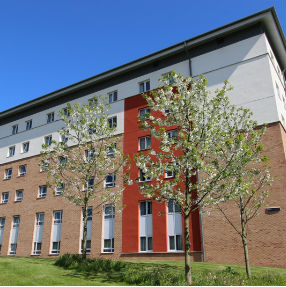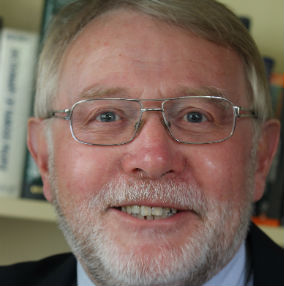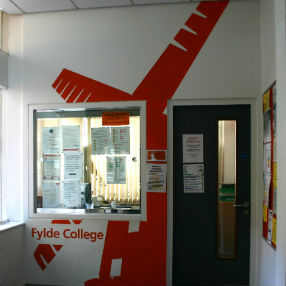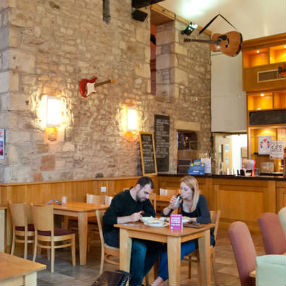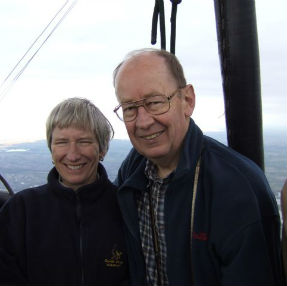Remember When
Here are some of the people and events that have made the University what it is today.
Send your memories and anecdotes (max 300 words plus a high resolution photograph) to alumni@lancaster.ac.uk.
We’ll include as many as we can.
The Establishment of Furness College
The fifth college to be established at Lancaster University, Furness College, was conceived in 1966, when a twelve person planning committee, chaired by the founding Principal of Furness, Professor Reynolds, was created to design the buildings and facilities of the college.
In 1968, Furness became the college that declared ‘Everywhere else is nowhere’. Currently, Furness is one of the smallest colleges, bringing in around 400 first year undergraduates each year, which furthers their reputation as a small, close-knit college.
The Furness logo is a cross-section of the Furness landscape and it provides an indication as to the nature of the region from which the college takes its name. The Furness region stretches from the industrial docklands of Barrow-in-Furness to the mountains of Coniston in the Lake District and has been witness to a turbulent history. In the twelfth century, Furness, alongside Cartmel, was taken under the wring of the Honour of Lancashire. For eight hundred years, Furness and Cartmel separated Morecambe Bay from the rest of Lancashire, and were only brought into Cumbria after the reorganisation of the county boundaries.
Despite the turmoil of the Furness region, the College is situated in the heart of campus, with each of its residence blocks being named after the towns and villages – as a permanent legacy brought into the hubbub of campus life. The College and its JCR are known for encouraging a vibrant social, cultural and sporting life amongst their students – the 15 hour bar crawl is a long-established tradition. Furness competes in the Patriots Cup each year against Cartmel which involves dozens of different sports played over the course of a weekend.
The Furness bar, Trevor, was refurbished and opened in 2012 much to the delight of students after being closed for over a year. In an interview in 2004 the President of Furness at the time, Emma Harper, spoke of the most important feature of life in Furness College: “All Furnessians are extremely friendly and up for a good time, which makes life in Furness a pleasant and fun atmosphere. I feel proud to belong to the best college on campus.” Another member of the JCR described the members, past and present, of Furness College as “one big happy family.”
Furness alumni include: Actor and screenwriter, Roger Ashton-Griffiths (Music, 1978), Labour MP for Tynemouth, Alan Campbell, (Politics 1978), Actor in 'The Office'', Harry Potter films, and 'Game of Thrones' Ralph Ineson (Theatre Studies, 1991) and Chief Executive of the Money Advice Service, Caroline Rookes CBE (English, 1975).
1968 Lancaster: The Times They Were A-Changing
For Martyn Sloman, Lancaster in the late 60s was an exciting place to be, especially if you were left of centre politically. To misquote Bob Dylan: the times they were a-changing – or so it seemed to him.
'The Labour Club was full of men and women who were the first of their working class families to enjoy higher education' Martyn remembers. 'The University at that time was about education, inclusion and individual development.' In Martyn’s view, 'sadly today the emphasis seems to be on positions in league tables achieved by researchers who spend their time competing with each other by writing papers that nobody reads.'
After graduation in 1968 Martyn spent the summer helping the campaign of the anti-Vietnam war US Presidential Candidate, Eugene McCarthy. He then worked for the National Coal Board as an economist and was a candidate at General Elections in the 1970s and 80s. For Martyn, the 1984-5 Miners' Strike was the turning point in his life. 'Watching Arthur Scargill, the Miners’ leader and Ian Macgregor, the NCB Chairman, in action was like seeing two prehistoric monsters having a fight. Evolution was clearly going to take place elsewhere.'
This realisation prompted a move into human resource development roles in City organisations and, over time, the genesis of a second career writing, researching and lecturing. Seven books led to three Visiting Professorships at UK Universities and a Fellowship at the University of Canterbury, New Zealand which, Martyn says, 'coincided neatly with the rugby season'. The culmination, however, was a visiting appointment as Extraordinary Professor at North West University, Potchefstroom, South Africa. Once the heart of apartheid, Martyn describes NWU now as 'a marvellous multi-racial institute with students fully representative of the rainbow nation. It has been a joy to teach there.' His experiences at NWU remind Martyn of standing amongst the Lancaster students resisting the visit from an all-white South African rugby team in the 1960s. 'Not all change is for the worse and NWU reminds me of Lancaster back in its earliest days'.
Martyn now lives in Norfolk where his wife of over forty years has family roots. He has just accepted the role of Parliamentary Agent for what he says is 'an excellent Labour Candidate' for North Norfolk in the 2015 General Election. Although exiled to the far side of the country from his native Wales he still enjoys his visits to the Millennium Stadium where he has debenture seats. 'I look forward to watching Cardiff lift the European Cup,' he says, 'and seeing the social and economic changes that I support implemented. I am not sure which of the two is the more likely!'
The Establishment of Fylde College
Fylde College holds pride of place at Lancaster as the sixth college, with the construction of the college buildings beginning in 1968 and students being accepted from 1969. The beginnings of Fylde College lie in the establishment of a group of young lecturers, who formed ‘College 6’, which they envisioned to be a commune-style College which students could have more influence over.
Originally, it was planned that students would begin to enter the college in 1970, but the first phase of Furness College was completed ahead of schedule and £125,000 under budget by 1968, so the University decided to begin work on the ‘Sixth College Project’ earlier than scheduled.
Officially opened in 1971, it celebrated its own 40th birthday in October 2011. The College motto ‘seek truth in the field’ is not just a nod to the University’s own, but it also refers to the world outside of the University walls. The College is named from the Fylde region, which spans the area of land between the Trough of Bowland, the Ribble Valley and the Irish Sea. The Windmill is the official logo of the college, which pays homage to the fact that at one point, there were over thirty-five windmills scattered along the Fylde Coast. The college expanded in 1970 with four more blocks and with more added in the early 1980s and 1990s.
In 2005, Fylde became the second college to be located on two separate sites and began to offer en-suite residence on the south-west side of campus. However, it has since been reunited on its original site and is now one of the smaller colleges on campus. Many of the main blocks were demolished, internally and externally, in order to completely refurbish accommodation alongside a mass refurbishment of the colleges by the University. In 2006, further efforts were made to improve the quality of room layouts and finished in Fylde, much of which was done in consultation with students. Fylde has a reputation for being the home of sport at Lancaster and the college competes in multiple inter-college tournaments such as Legends and Carter Shield.
The Establishment of Cartmel College
Cartmel College, founded in 1968, is named for the Cartmel peninsula which is deemed to be one of the most beautiful areas in Cumbria and remains home to the famous Cartmel Priory.
Cartmel College and the University embroiled in a scandal in May 1968, when Lancaster student-run publication Carolynne published a piece about a confidential meeting of the Cartmel College syndicate, at which the idea of mixed corridors when the college became residential was discussed. It was supported by the Dean-Elect of the college, Dr David Craig, who stated that he believed students should also have mixed bedrooms if they wished. Founding Vice-Chancellor of Lancaster University, Charles Carter, spoke in 1963 of his desire to find ways for male and female social students to socialise with each other within the colleges, but after fears of donation withdrawals in the light of the Carolynne article in 1968 he stated: “No arrangements would be made which might in any way be interpreted as an invitation to sexual licence.” Nowadays, of course, all college residences are mixed sex.
In 2004, Cartmel accommodation was relocated from the top of campus to Alexandra Park, as part of the new development in the southwest campus centred round Barker House Farm. The old Cartmel buildings towards the north of the Bailrigg campus became County South and were originally designed by Manchester-based architect Haydyn Smith. Smith planned the structure of the college in order to expose it to as much natural light as possible, although with Lancaster’s reputation for cloudy skies, it is debatable how much sunlight the buildings enjoy!
Barker House Farm is an integral part of the Cartmel dining hall and bar, as although it was originally purchased to be sports fields, it was deemed to be suitable for either arts teaching or student residences. In the end, it was decided that the development would be a part of the south west campus project and the plan was to surround and incorporate the listed buildings of Barker House Farm into the soon-to-be Cartmel College residents. Barker House Farm, which is now the core of the Cartmel College dining facilities, features a lintel above a window which was built in approximately 1691, and is engraved with the initials for a Richard (1644-1711) and Jennet (birth date unknown – 1713) Barker. It was opened by Her Royal Highness Prince Alexandra in December 2004 as her last official duty as Chancellor.
Alumni from Cartmel include: Simon Danczuk (Sociology, 1992) currently MP for Rochdale, David Watson (Politics, 1998), Senior Campaigns Manager for the Prime Minister's Office and Rainer Hersh, (Economics, 1985), Presenter, Comedian & Musician
Another One of Our Longest Married Alumni Couples!
Last year we appealed for suggestions for the longest married alumni couple through STEPS and our alumni Facebook page and Paul and Caroline came forward as potential qualifiers.
Paul and Caroline (nee de Vries) Skinner are another one of our longest alumni married couples!
Paul (Lonsdale) and Caroline (Bowland) both studied French and met at Lancaster in 1965 when the University was based in St.Leonardsgate and they married in 1968. They now live in Northamptonshire.
Paul worked in leather sales until he retired in 2007 and is now a volunteer driver for the Guide Dogs.
Caroline has increasing blindness caused by retinitis pigmentosa. She is training her fourth guide dog. She is secretary of the local blind club and a speaker for Guide Dogs. As part of international efforts to find a treatment or cure for retinitis pigmentosa, Caroline was one of six candidates in Oxford selected for a trial tiny electronic retinal implant developed in Germany, which gave her 2 months of visual awareness. Channel 4's film "How to build a bionic man" featured Caroline and the operation and her hopes that this will help future generations.


